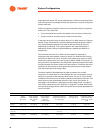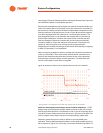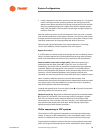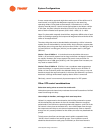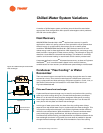
66 Chiller System Design and Control SYS-APM001-EN
System Configurations
A more conservative approach might be to wait to turn off the chiller until it
would result in no higher than 80 percent capacity for the remaining
operating chillers. Going back to the example, if the desired (n-1) chiller
capacity were 80 percent, it would not be appropriate to shut down a chiller.
In this case, the plant controller should not turn off any of the chillers until
each of them unloaded to 53 percent; (53% + 53% + 53%) / (3-1) = 80%.
Note: For plants with unequally sized chillers, weight the %RLA value of each
chiller by its design capacity and compare the weighted value with that of the
chiller to be sequenced off.
The other thing that must be checked before subtracting a chiller is how the
system flow can be handled by one less chiller. As an example, suppose that
two chillers are running near their minimum flow. Chiller 1 is at 650 gpm [41.0
L/s] and Chiller 2 is at 760 gpm [47.9 L/s], so the system total is 1,410 gpm
[88.9 L/s].
Choice 1: Turn off Chiller 1. It is obvious that we should be able to turn
Chiller 1 off and satisfy system load as long as the flow rate doesn’t increase
too rapidly. However, the current system flow rate is close to Chiller 2’s
design flow rate of 1440 gpm [90.8 L/s], and if the system flow increases, we
may need to restart Chiller 1.
Choice 2: Turn off Chiller 2. If Chiller 1 has a condenser water temperature
lower than design, its capacity has increased. Could we turn off Chiller 2?
Chiller 1’s flow is certainly within the allowable limits, but it may or may not
be able to supply the required capacity. In this case, the dilemma is to ensure
that there is enough chilled water capacity after a chiller is turned off.
Obviously, control is an extremely important aspect of a VPF system.
Other VPF control considerations
Select slow-acting valves to control the airside coils.
Valves that open and close slowly moderate the normal fluctuations of chilled
water flow through the loop.
Use multiple air handlers, and stagger their start/stop times.
Unless it is programmed to do otherwise, the building automation system
will simultaneously shut down all of the air handlers when the occupied
period ends. If two chillers are operating when this happens—and if all of the
coil-control valves close at the same time—then chilled water flow through
the evaporators will drop to zero almost instantaneously. Such a dramatic
change not only causes problems for the chillers, but also may deadhead the
pumps.
To help ensure that flow-rate changes remain within acceptable limits,
“divide” the air handlers into several groups. Then implement control
schedules that shut down each group individually at 10-minute intervals.



